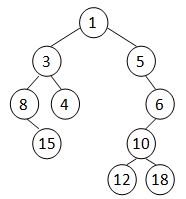7-4 Cartesian Tree (30分)
A Cartesian tree is a binary tree constructed from a sequence of distinct numbers. The tree is heap-ordered, and an inorder traversal returns the original sequence. For example, given the sequence { 8, 15, 3, 4, 1, 5, 12, 10, 18, 6 }, the min-heap Cartesian tree is shown by the figure.

Your job is to output the level-order traversal sequence of the min-heap Cartesian tree.
Input Specification:
Each input file contains one test case. Each case starts from giving a positive integer N (≤30), and then N distinct numbers in the next line, separated by a space. All the numbers are in the range of int.
Output Specification:
For each test case, print in a line the level-order traversal sequence of the min-heap Cartesian tree. All the numbers in a line must be separated by exactly one space, and there must be no extra space at the beginning or the end of the line.
Sample Input:
10
8 15 3 4 1 5 12 10 18 6
Sample Output:
1 3 5 8 4 6 15 10 12 18
#include <iostream>
#include <queue>
#include <vector>
#include <unordered_map>
using namespace std;
const int N = 30 + 10, inf = 214748367;
int q[N], rt;
unordered_map <int, int> pos, L, R;
int build(int l, int r)
{
int root = inf;
for(int i = l; i <= r; i ++) root = min(root, q[i]);
if(pos[root] > l) L[root] = build(l, pos[root] - 1);
if(pos[root] < r) R[root] = build(pos[root] + 1, r);
return root;
}
int main()
{
int n;
cin >> n;
for(int i = 0; i < n; i ++)
{
cin >> q[i];
pos[q[i]] = i;
}
rt = build(0, n - 1);
vector <int> ans;
queue <int> lev;
lev.push(rt);
while(lev.size())
{
int t = lev.front();
ans.push_back(t);
lev.pop();
if(L.count(t)) lev.push(L[t]);
if(R.count(t)) lev.push(R[t]);
}
cout << ans[0];
for(int i = 1; i < ans.size(); i ++) cout << ' ' << ans[i];
return 0;
}

